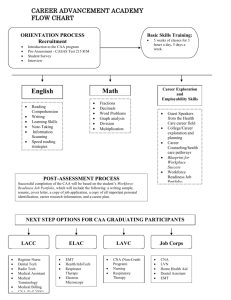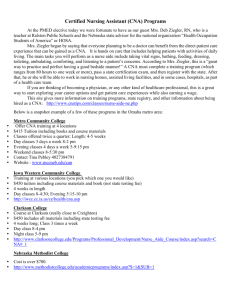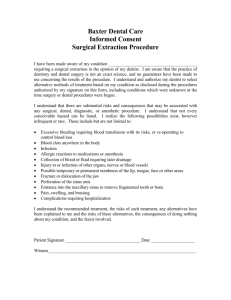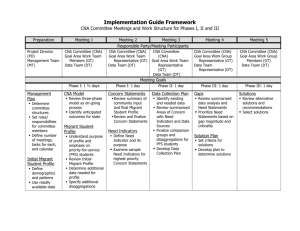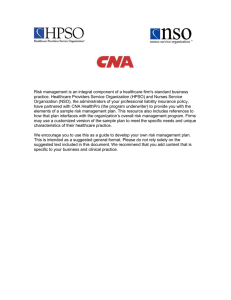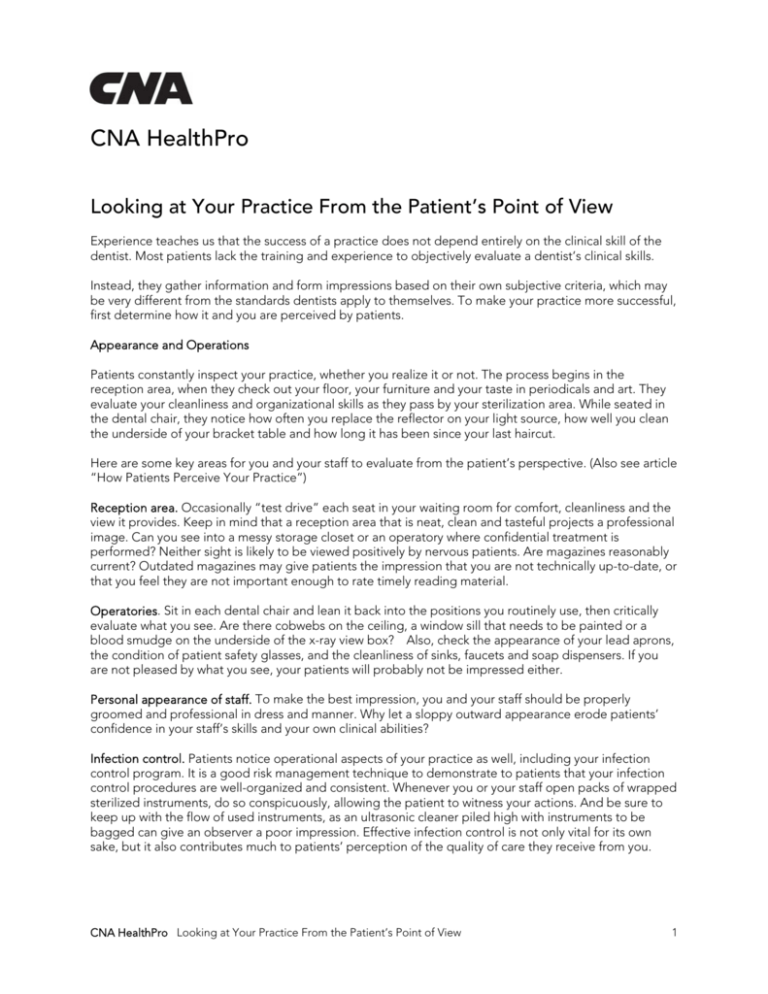
CNA HealthPro
Looking at Your Practice From the Patient’s Point of View
Experience teaches us that the success of a practice does not depend entirely on the clinical skill of the
dentist. Most patients lack the training and experience to objectively evaluate a dentist’s clinical skills.
Instead, they gather information and form impressions based on their own subjective criteria, which may
be very different from the standards dentists apply to themselves. To make your practice more successful,
first determine how it and you are perceived by patients.
Appearance and Operations
Patients constantly inspect your practice, whether you realize it or not. The process begins in the
reception area, when they check out your floor, your furniture and your taste in periodicals and art. They
evaluate your cleanliness and organizational skills as they pass by your sterilization area. While seated in
the dental chair, they notice how often you replace the reflector on your light source, how well you clean
the underside of your bracket table and how long it has been since your last haircut.
Here are some key areas for you and your staff to evaluate from the patient’s perspective. (Also see article
“How Patients Perceive Your Practice”)
Reception area. Occasionally “test drive” each seat in your waiting room for comfort, cleanliness and the
view it provides. Keep in mind that a reception area that is neat, clean and tasteful projects a professional
image. Can you see into a messy storage closet or an operatory where confidential treatment is
performed? Neither sight is likely to be viewed positively by nervous patients. Are magazines reasonably
current? Outdated magazines may give patients the impression that you are not technically up-to-date, or
that you feel they are not important enough to rate timely reading material.
Operatories. Sit in each dental chair and lean it back into the positions you routinely use, then critically
evaluate what you see. Are there cobwebs on the ceiling, a window sill that needs to be painted or a
blood smudge on the underside of the x-ray view box? Also, check the appearance of your lead aprons,
the condition of patient safety glasses, and the cleanliness of sinks, faucets and soap dispensers. If you
are not pleased by what you see, your patients will probably not be impressed either.
Personal appearance of staff. To make the best impression, you and your staff should be properly
groomed and professional in dress and manner. Why let a sloppy outward appearance erode patients’
confidence in your staff’s skills and your own clinical abilities?
Infection control. Patients notice operational aspects of your practice as well, including your infection
control program. It is a good risk management technique to demonstrate to patients that your infection
control procedures are well-organized and consistent. Whenever you or your staff open packs of wrapped
sterilized instruments, do so conspicuously, allowing the patient to witness your actions. And be sure to
keep up with the flow of used instruments, as an ultrasonic cleaner piled high with instruments to be
bagged can give an observer a poor impression. Effective infection control is not only vital for its own
sake, but it also contributes much to patients’ perception of the quality of care they receive from you.
CNA HealthPro Looking at Your Practice From the Patient’s Point of View
1
Communication Issues
Communication is one of the most critical aspects of dental practice. It is the foundation of patients’
treatment decisions, informed consent, postoperative care and all other dealings with your practice.
Seemingly simple communication skills such as managing the telephone, scheduling appointments and
answering patient inquiries can affect patient satisfaction. A courteous and respectful communication
style creates a good impression and helps build long-lasting patient relationships.
The way in which you and your staff speak and interact with each other and with patients conveys your
courtesy and professionalism. A patient who senses conflict among office members will feel less
comfortable than one who observes a group working together as a team. Skills can be taught, but
kindness, empathy and concern are innate qualities that cannot be learned.
Unintended and/or unauthorized communication can often be a concern for patients. In many offices,
patients seated in the reception area can clearly overhear private conversations between staff and other
patients in the front desk area or in operatories and other patient care areas. If patients overhear
conversations not intended for their ears, it may significantly erode their confidence in your practice’s
ability to protect their privacy.
Open bay operatories may also lead to breaches of patient confidentiality. Conversations among you,
your staff and your patients concerning health history, treatment decisions or financial affairs are private
in nature and should be either conducted in hushed tones or restricted to a more private setting.
Scheduling
How do you react when your own dentist or physician is behind schedule for your appointment? Do you
get agitated, annoyed or downright angry? Patients may construe long waits as a message that their time
is not as valuable as yours. Your delays upset their schedules and contribute to decreased patient
tolerance and levels of satisfaction.
Respect their time. Schedule patients realistically and make an extra effort to keep to your schedule. If
you fall behind schedule, tell your patients and offer to reschedule those who will be inconvenienced. It is
very helpful to offer your apologies on top of your staff’s and to explain the reason for the delay. It is no
less than you would expect if you were the patient.
Dentists operate a service business and must periodically assess whether their practice is customerfocused. Strive to make your office a clean and comfortable place where
•
patients are treated at their scheduled appointment time
•
staff members know patients by name
•
interruptions during treatment are kept to a minimum
•
a smile and some pleasant conversation are never too much trouble
By conducting your practice in a manner that makes patients comfortable and that shows you care about
them as people, you will reap the many benefits of customer satisfaction.
This publication is for educational purposes only. It is not legal or dental advice. CNA makes no representations as to its correctness
or completeness and accepts no liability for any injury or damage that may arise from its use. Specific legal or dental questions
should be referred to a competent attorney or dental professional. This material may address and discuss matters for which your
policy does not provide coverage, and the material does not create or imply the existence of coverage. Please consult your
insurance policy for the specific terms and conditions of coverage.
CNA policies are underwritten by the property/casualty companies of CNA, Chicago, IL. CNA is a registered service mark of CNA
Financial Corporation. ©2005 Continental Casualty Company. All rights reserved.
CNA HealthPro Looking at Your Practice From the Patient’s Point of View
2

